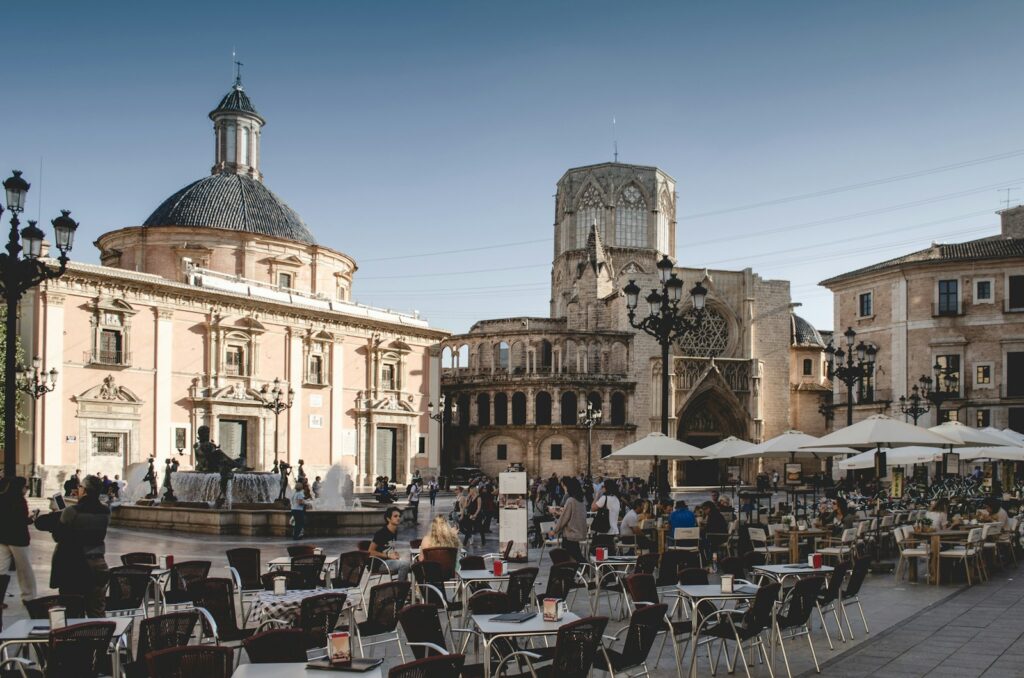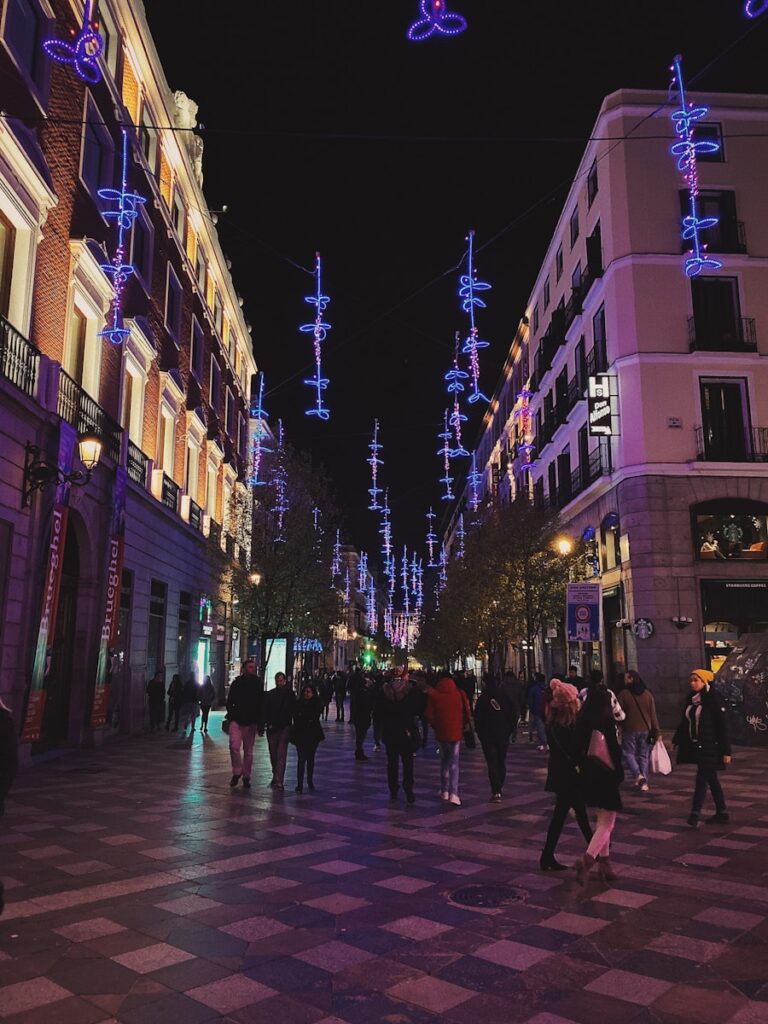The ultimate guide to relocating to Madrid in 2024
Coming up: food and flavors, learning the language, necessary bureaucracy, the best neighborhoods for different types of people, and everything you need to know about moving to Madrid.
So, you’re thinking about moving to Madrid.
Here’s what we think: you’re making a good decision!
Spain’s capital city (and the nation’s biggest city!), it’s a cosmopolitan place where over 180 nationalities live (and where over 15% of the city’s dwellers come from somewhere outside of Spain).
Perks of moving to Madrid include a great quality of life, a digital nomad visa, the ease of making friends, world-class public transport, easy connections to the rest of the planet, and plenty more.
… so coming up, we’ve covered all that—along with information on prices, people, local culture, and how to find a nice place to live (which is trickier than most people expect).
Today, your good buddies at Homelike have brought you everything you need to know about relocating to Madrid. Bring some tapas and come join the party!
Why move to Madrid?
Some of the biggest perks of moving to Madrid include:
- Good prices: okay, Madrid isn’t the cheapest place in the world. But it’s much more affordable than many other parts of western Europe. If you’re moving from another western-European capital city, expect to be pleasantly surprised. We’ve covered specific prices soon.
- World-class nightlife: for drinking and dancing, Madrid is one of the best cities on the planet. Allegedly, Spain’s capital is home to around “18000 bars, restaurants and clubs”—and many clubs stay open beyond daybreak.
- Great quality of life: work-life balance is great, food is healthy, people live very sociable lifestyles, and Madrid has the highest life expectancy of all the EU’s regions. Combine that with friendly people, good travel opportunities, and lots of sunshine, and you’re set for a world-class life.
- A great cultural balance: although it’s a super-cosmopolitan city, Madrid is also in many ways very traditional. It has all the perks that come with a capital city, but also retains an old-school Spanish charm. If you want a combo of modern and retro, you’ll love it.
- Excellent weather: admittedly, Madrid is a little rainier than some people expect (with around 60 days of rainfall per year). But you still get plenty of sunshine. And in the heart of summer, you get up to 15 hours of sunlight per day.
- Incredible food: as you probably know, Spanish food is some of the best in the world. But because Madrid is so cosmopolitan, you also get high-quality food from around the planet (which isn’t always the case in other parts of Spain).
- A well-connected airport: presumably, you’re the type of person who likes to travel. Well, good news: Madrid is home to the nation’s biggest airport, with direct connections to over 200 different cities across the world. And because Madrid lies right in the center of Spain, it’s in an ideal spot for reaching other parts of the nation.
- It’s easy to make friends: Spanish people are friendly, the city is big (so you’ll always find people who are interested in whatever hobbies you’re interested in), and there are people here from around the planet. For making friends, Madrid is arguably the best city in Spain.
Just for a bit of balance, some of the cons of moving to Madrid include a lot of busy bustle, the sometimes-stifling summer heat, and the often-overwhelming difficulty of finding a nice place to live.
… but for most people, the perks of relocating to Madrid DEFINITELY outweigh the cons.

Visa requirements for moving to Madrid
If you’re moving to Madrid from another part of the EU/EEA, good news: you DO NOT need a visa. And if you’ll be staying for 90 days or fewer, you don’t need to do anything at all. But if you plan to stay for more than 90 days, you need to register your residence, and get your NIE number (that’s your ‘Foreigner Identity Number’). More details on that NIE soon.
If you’re moving to Madrid from outside the EU/EEA area, you WILL need a visa*. Which visa you’ll need will depend on exactly what you’re doing in Madrid (working, studying, meeting family, etc). Here’s a list of all your options.
*that said, some nationalities can visit Spain for up to 90 days with no visa (including people from the UK, the USA, Japan, South Korea, and many more. Here’s a full list.
… and if you’re moving to Spain as a digital nomad: Spain recently released a digital nomad visa. To apply, you must earn at least $2700 per month (that’s $32400 per year), and have proof of these earnings (e.g. bank statements or invoices or whatever). Other requirements include a valid passport, and a clean criminal record.
Best neighborhoods to live in Madrid
- Sol: if you’re only moving to Madrid for a short while, this is where you’ll want to live. The very-central part of the very-central area, it’s where you’ll find all the bustle, all the tourists, and many of the city’s most well-known attractions. Expect to spend most of your time here eating, drinking, dancing, and partying.
- Malasaña and Justicia: sitting right beside one another, these two districts are very similar to each other. They’re both hip and happening nightlife hubs, where you’ll find bohemians, brunch spots, vintage stores, many young people, and some of the city’s best nightclubs and events. Justicia in particular is popular with the LGBTQIA+ community, who hang around the well-known Chueca neighborhood.
- Las Tablas: ideal for relocating to Madrid with kids. Sitting far north of the city center, Las Tablas is home to international schools, spacious homes, many families, good job opportunities, a university, budget-friendly areas, and close proximity to the city’s airport.
- Usera: an up-and-coming neighborhood for moving to Madrid. A big district south of the center, it features affordable housing, friendly people, underground artistic areas, the city’s Chinatown, and a very diverse group of residents. And because it’s multicultural, it’s easy to make friends here.
La Latina: if you’re relocating to Madrid for ‘real’ Spanish vibes, you’ll love this neighborhood. One of the prettiest and most romantic areas in the city, it’s home to cobbled streets, lifelong locals, wrinkled faces, great tapas, and a mixture of Spaniards and foreigners. It sort of feels like a little busy village right inside the center of Madrid.
… for more detail, we’ve covered all these districts and more in our big guide to the 10 best neighborhoods in Madrid.
Finding accommodation in Madrid (trickier than you might expect!)
After moving to Madrid, one of your biggest challenges will be finding a nice place to live. People are moving to the city every day, native speakers have an advantage over you, local landlords often charge high prices for bad places, and you’ll need to spend weeks viewing different options.
For those reasons, many of Madrid’s newcomers decide to move into serviced apartments. With a serviced apartment, you don’t need to do any bargaining or negotiating, you don’t need to pay a deposit, and you don’t need to hunt for any furniture.
… and some even better news for you: all of our serviced apartments are comfy and cozy, perfect for living and working in, and ready to move into TODAY.
That said, you don’t absolutely need to use us here at Homelike (although, obviously, we think we’re the best option 😉). Other good websites for finding a place to live in Madrid include Idealista and Fotocasa—and you’ll find many housing groups on Facebook.
Average rents you can expect to find after moving to Madrid typically sit at:
- 1-bedroom apartment in the city center: €1,190
- 1-bedroom apartment outside the city center: €870
- 3-bedroom apartment in the city center: €2,120
- 3-bedroom apartment outside the city center: €1,420
And to BUY a home after relocating to Madrid, Idealista and Fotocasa are the two best websites.
… but to buy a place, we recommend working with an agent—buying a home is difficult enough in your home country; but it’s even more difficult in a country where you don’t understand the local language or bureaucracy. Agents understand the market, they know its weird intricacies, and they can support you through the entire process.

Navigating bureaucracy in Madrid
After relocating to Madrid, you’ll (of course!) have some bureaucratic stuff to think about.
Your three biggest tasks are:
- Registering your residence (known as ‘getting your empadronamiento,’ this is basically just the process of registering your long-term presence in Spain)
- Getting your foreigner identification number (which is also known as your ‘NIE,’ and is essentially just a tax number )
- … and opening a bank account (we don’t think this one requires much explanation)
To get your empadronamiento (in case you’re curious, the word ‘empadronamiento’ translates to ‘census’), you can either head to your closest town hall in Madrid (‘ayuntamiento,’ in Spanish), or you can apply online here. The process is a legal requirement—and you need to do it even if you’re Spanish, or even if you’re moved to Madrid from another part of Spain. That said, you only need to go through the process if you’ll be in Madrid for 6 months or more.
To get your NIE number (which is also known as a ‘unique foreigner identification number,’ you can visit your nearest immigration office in Madrid, or you can visit your local Spanish embassy in your home country (before arriving in Spain, obviously). Again, EVERYONE needs to have an NIE number (assuming you’re planning to be in Spain for three months or more).
To open a bank account after moving to Madrid, you usually need to provide ID (like your passport), your NIE number, your proof of address (even if it’s just a temporary address), and proof of your employment status (or study status). Three of Spain’s most popular banks are BBVA, Santander, and Banco Sabadell…
… but we recommend opening an online-only account through an app. If you open an app-based online-only account, the signups are faster, you don’t need to visit an actual building, and you can start and finish the process within minutes. The best online-only banks in Spain are

Learning Spanish for moving to Madrid
If you’ll be moving to Madrid for more than a few months, you should learn Spanish.
… life will become easier, bureaucracy will be more manageable, you’ll make more friends, and you’ll better understand shopping and life admin and all those other daily tasks.
To get started, your best option is good ol’ Duolingo—it’s more immersive and extensive than most people expect, and you can build a good foundation by what basically just feels like playing a game. After you’re ready to go further, the best options are Babbel and Rosetta Stone, which are a bit more serious and academic than Duolingo.
If you want some face-to-face online lessons, try Lingoda and Preply, both of which combine real tutors with many other resources. And for EVEN MORE ideas, here’s a list of our 10 favorite language-learning apps.
After relocating to Madrid, you’ll also find many Spanish-teaching language schools in the city (and there’ll probably be one in whichever neighborhood you’re living in). We won’t go into too much detail here—but this list is a good place to start your search.
Madrid’s culture and people
After moving to Madrid, you’ll probably find it pretty easy to make friends—almost 20% of the city’s residents speak high levels of English.
(… that said, you’ll of course find it easier to make friends if you can speak Spanish!)
Broadly speaking, Spanish people are open, friendly, warm, and hospitable (no matter who you are or where you’re from). They’re proud of their culture and heritage, they love eating and drinking with their loved ones, and they like to party. But like in any big city, you’ll find a wide range of people!
Because Madrid is so cosmopolitan and multicultural, people here aren’t quite as traditional as the local people you might find in smaller Spanish places, or in cities like Valencia or Granada. And because Madrid attracts so many tourists and expats, you’ll always find a big mix of people.
To make friends, the best place to start is Facebook. You can use the site to find generic find-friending and event-finding groups (like this one, this one, this one and this one)—and you should also be able to find hobby-specific groups with people who share the same interests as you (whether that’s running, hiking, cycling, crocheting, playing chess, or whatever else!).
Another good option is the Couchsurfing app. On the app, you’ll find both locals and foreigners, and people staying both short-term and long-term. But the app’s biggest perk is: you’ll typically find Madrid locals who are keen to make friends with the city’s newbies.
… and because there’s such a big expat culture in Madrid (around 1 million of the city’s metropolitan population is from somewhere outside of Spain!), you should be able to find people who come from wherever you come from. A nice way to find a little pocket of home in the city!
For much more, here’s a big list of all the cultural shocks and expectations you might find after moving to Spain.
Quality of life in Madrid
After relocating to Madrid, you’ll find a top-class quality of life:
In the InterNations ‘Expat City Ranking 2023’ report, Madrid came 3rd IN THE WORLD for overall quality of life.
In that same report, it also ranked:
- 8th for healthcare
- 1st for leisure options
- 1st for culture and nightlife
- 14th for safety and security
- 5th for affordability of public transport
- 4th for culinary variety and dining options
- … and 7th for opportunities for recreational sports
You’ll also find a great work-life balance in Madrid:
Workers take long lunch hours, all employees are legally entitled to a minimum of 30 calendar days of holiday per year, and very few people are expected to work outside of their work hours. Locals also place a big emphasis on spending time with family and friends—and as we’ve covered, the cost of living is great.
Overall, for quality of life, Madrid is one of the best places on the planet. No matter where you’re moving from, you’ll probably find your quality of life increases after moving to Madrid. And on top of all that, the weather is great!
Transport in Madrid
Madrid’s public transport system is among the best in Spain—it’s massive, it reaches every pocket of the city, and it’s easy to use and easy to understand.
After moving to Madrid, you’ll get:
- 12 metro lines
- around 2,000 buses
- over 300 metro stations
- … and more than 50 light rail stations
After moving to Madrid, you should get yourself an ‘abono.’ A card-based monthly pass, it lets you travel endlessly across Madrid for just over €50 per month (€20 per month if you’re under 26).
Another popular option for getting around the city is Madrid’s collection of e-Bikes. You can use these e-Bikes for an entire year for only €15(!) if you have an abono. Meanwhile, the city is also home to both e-Scooters and motor scooters.
For cycling, Madrid admittedly isn’t great. But the infrastructure is improving all the time—more bike lanes are popping up, drivers are becoming more tolerant of cyclists, and more of the city’s residents are beginning to use cycling as their main form of transport.
Obviously, because Madrid’s public transport is so good, you can get around the entire city without needing a car. And you can reach most places from Madrid without one (by using the nation’s extensive bus and train network!). But if you’ll be regularly traveling around the nation, you should get a car—just remember to drive on the right-hand side of the road, and remember that people in Spain might drive a little faster than you might be used to!
Madrid is a pleasant city for walking. Although it’s too big to get around exclusively by foot, the sidewalks are wide, you’ll find plenty of pedestrian crossings, and in 2022, “the community of Madrid invest[ed] 5 million euros to improve the pedestrian accessibility of the regional road network.”
The cost of living in Madrid
Here are the types of prices you can expect to pay after relocating to Madrid:
- One-way ticket on local public transport: €1.50
- Regular monthly pass for local public transport: €50
- Meal for 1 at an inexpensive restaurant: €14
- 3-course meal for 2 people at a mid-range restaurant: €60
- Large draught domestic beer in a bar or restaurant: €3
- Regular cappuccino in a cafe or restaurant: €2.40
- Loaf of white bread from a supermarket: €1.50
- 12 regular eggs from a supermarket: €2.80
- 1kg of chicken breast filets from a supermarket: €7.50
(FYI: for housing costs, we already covered rental prices earlier in this guide, in the ‘finding accommodation’ section above)
… by the way, we’ve taken all figures from Numbeo, where you can find crowd-sourced (and accurate!) cost-of-living stats for pretty much any place on the planet.

Moving to Madrid from the UK
After moving to Madrid from the UK, cultural differences you might encounter include:
- The weather is better
- Life is more relaxed and laid-back
- People are more tactile, warm, and open
- You’ll have a much better work-life balance
- Local food is better—but culinary diversity is a little more narrow
- Dinner is eaten a lot later (and dinner is bigger, and breakfast is smaller)
- Life is a little cheaper (maybe a LOT cheaper, if you’re moving from southern UK!)
- You’ll find it easy to make friends—Spanish people are friendly, and as you probably know, lots of English people choose to retire in Spain
… and as we already mentioned, for stays of more than 90 days, you’ll need the appropriate visa.
Moving to Madrid from the US
After moving to Madrid from the US, some changes you’ll find include:
- Breakfast is way smaller
- Life has a much slower, gentler pace
- There’s a greater focus on spending time with family
- Cars are less common, and public transport is much better
- There’s no real tipping culture—around 10% is the maximum you should tip (which is of course appreciated, though not expected)
And, again, for stays of more than 90 days, you’ll need the appropriate visa (as outlined earlier in this guide).
Moving to Madrid as a digital nomad
If you’re relocating to Madrid as a digital nomad, you can take advantage of the nation’s digital nomad visa.
Because of this visa (and because of all the perks of living in Madrid!)…
…. you’ll find MANY other digital nomads living here. Which means lots of coworking spaces, many work-friendly cafes, and a huge number of networking events and opportunities—and it’s easy to make friends!
In short, Madrid is a perfect destination for digital nomads.
Moving to Madrid: final thoughts
Okay, we’re done—and hopefully we’ve covered everything you wanted to know about moving to Madrid!
To recap, one of the biggest challenges of relocating to Madrid is finding a nice apartment. Natives have the advantage over you, there’s endless competition for each apartment, and you often need to spend weeks negotiating with sometimes-sneaky landlords.
… to avoid all the stress and fuss, do what many other Madrid newcomers do: and move into one of our serviced apartments. They’re fully-furnished, comfy and cozy, and ready to move into today. And because we display all prices, you don’t need to do any bargaining or negotiating!
Anyway, no matter how you find your apartment, we reckon you’ll love living in Madrid—just like everyone else does!
Thanks for reading, thanks for choosing Homelike, and enjoy your new life in Spain. Adios!






















